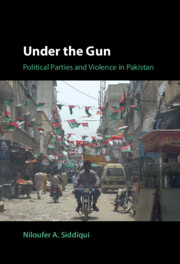Book contents
- Under the Gun
- Under the Gun
- Copyright page
- Dedication
- Contents
- Figures
- Tables
- Acknowledgments
- Abbreviations
- 1 Introduction
- 2 The Logic of Party Violence
- 3 Setting the Stage
- 4 Who Owns the Guns? the Muttahida Qaumi Movement and Violence in Karachi
- 5 The Pakistan Peoples Party and the Gangs of Lyari, Karachi
- 6 Allying with Militants? the Pakistan Muslim League-Nawaz and Sectarian Groups in Punjab
- 7 An Ideology of Nonviolence? the Awami National Party in Khyber Pakhtunkhwa
- 8 Party Violence in Comparative Perspective
- 9 Conclusion
- Appendix
- Bibliography
- Index
2 - The Logic of Party Violence
Published online by Cambridge University Press: 18 November 2022
- Under the Gun
- Under the Gun
- Copyright page
- Dedication
- Contents
- Figures
- Tables
- Acknowledgments
- Abbreviations
- 1 Introduction
- 2 The Logic of Party Violence
- 3 Setting the Stage
- 4 Who Owns the Guns? the Muttahida Qaumi Movement and Violence in Karachi
- 5 The Pakistan Peoples Party and the Gangs of Lyari, Karachi
- 6 Allying with Militants? the Pakistan Muslim League-Nawaz and Sectarian Groups in Punjab
- 7 An Ideology of Nonviolence? the Awami National Party in Khyber Pakhtunkhwa
- 8 Party Violence in Comparative Perspective
- 9 Conclusion
- Appendix
- Bibliography
- Index
Summary
Chapter 2 presents my theory of party violence in more detail. I explain why parties choose to engage in violence despite its costs, which parties are most likely to do so, and the strategies of violence they employ. I focus on two types of political landscapes of weak state capacity – landscapes of shared sovereignty and landscapes of multiple competing sovereigns – where parties face differing incentives for violence. I explain that the extent to which voters impose costs on parties depends on whether the party has a captive support base. Assuming a party does engage in violence, the party’s organizational structure is key to whether it will do so directly through its own party members or whether it will outsource the task to a street-level violence specialist. I also highlight a third way in which parties engage in violence: through electoral alliances with elite violence specialists. Each of these strategies of violence has different predictions for the nature and level of the violence that follows. This chapter also explains the origins of these key variables and argues that they are exogenous to party strategy.
- Type
- Chapter
- Information
- Under the GunPolitical Parties and Violence in Pakistan, pp. 23 - 51Publisher: Cambridge University PressPrint publication year: 2022

